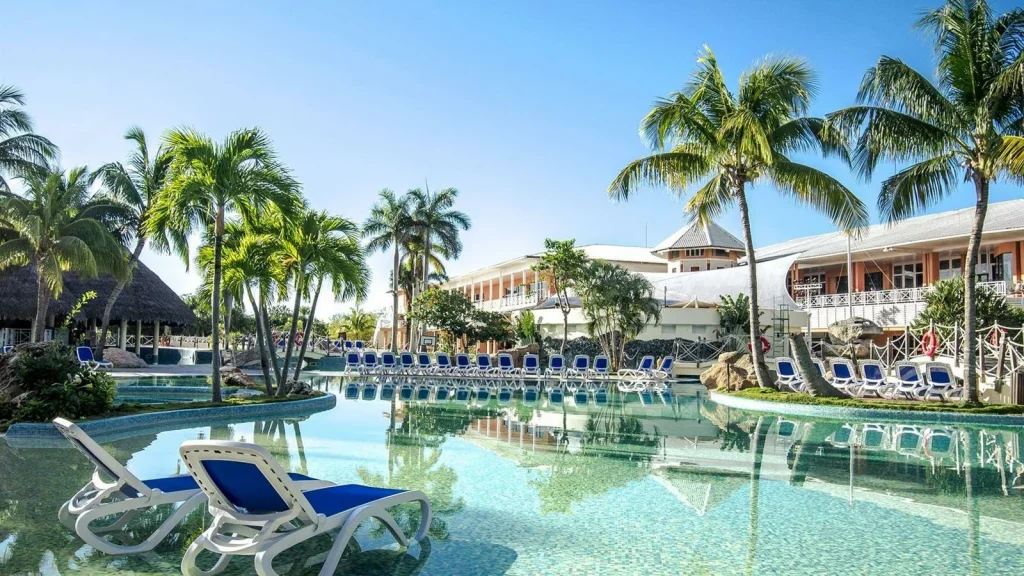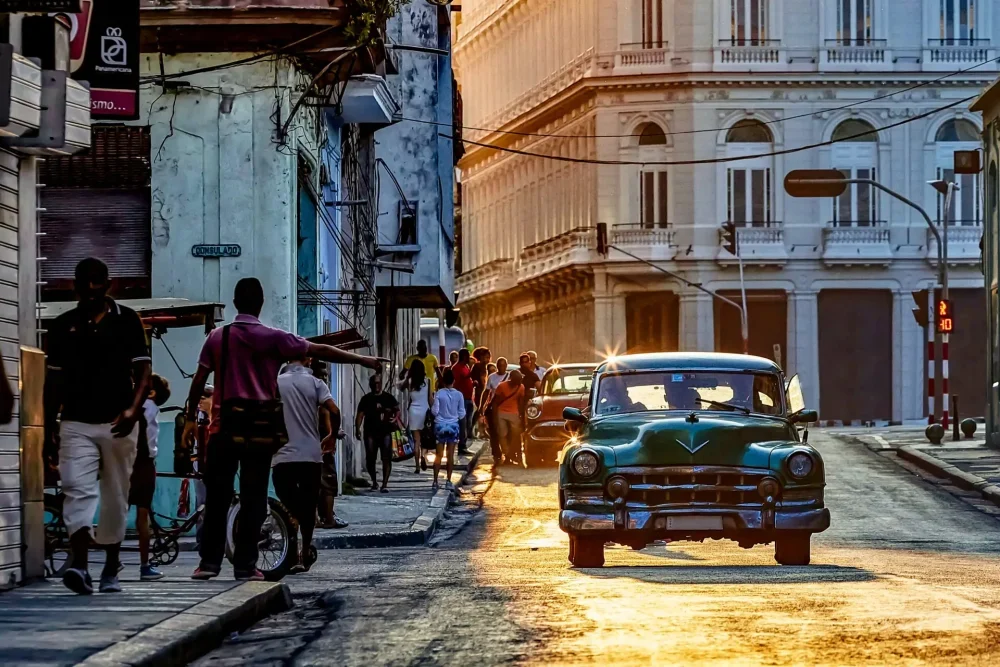Cuba in 2025 reaffirms its status as one of the most sought-after tourist destinations in the Caribbean region. The island’s resorts offer a huge range of options for holidaymakers, among which comfortable mid-range hotels are particularly popular. The best 5-star hotels in Cuba set the standard for luxury, but hotels in the 4-star category offer an optimal balance of price and quality. The selection will help tourists to choose the right place, where the holiday combines high service and excellent infrastructure.
Sol Caribe Beach: focus on family holidays
Sol Caribe Beach deservedly takes a place in the list of the best hotels in Cuba due to its service, despite its 4 stars. The resort complex is located in Varadero and is oriented on family leisure. The territory of the hotel includes spacious pools, children’s clubs and animation. All-inclusive breakfasts and lunches offer a rich selection of local and international cuisine. Rooms are air-conditioned and have balconies overlooking the Caribbean Sea.
Infrastructure and features:
- Private beach with white sand.
-
Equipped fitness centre.
-
Tennis courts and SPA area.

-
Possibility of booking excursions in Varadero.
Accommodation prices start from 120 USD per night for double occupancy. Reviews of hotels in Cuba among the 4-star categories emphasise the special atmosphere of comfort and safety in Sol Caribe Beach.
Hotel Puntarena Playa Caleta: availability at one of Cuba’s best 4 star hotels
 The hotel is also located in Varadero and is considered one of the leaders for tourists choosing the best 4 star hotels in Cuba in terms of service. The complex consists of two buildings with renovated interiors. Freshwater pools, bars at the water’s edge and an extensive entertainment programme create ideal conditions for an active holiday. Travellers note the convenient location of the hotel near the main attractions and a clean beach with a gentle entrance to the sea. Breakfast and dinner are included in the price of accommodation. Prices start from 110 USD per night.
The hotel is also located in Varadero and is considered one of the leaders for tourists choosing the best 4 star hotels in Cuba in terms of service. The complex consists of two buildings with renovated interiors. Freshwater pools, bars at the water’s edge and an extensive entertainment programme create ideal conditions for an active holiday. Travellers note the convenient location of the hotel near the main attractions and a clean beach with a gentle entrance to the sea. Breakfast and dinner are included in the price of accommodation. Prices start from 110 USD per night.
Mystique Casa Perla by Royalton: exclusive in Havana
Mystique Casa Perla by Royalton opens the list of those places that combine style, luxury and comfort. Havana attracts tourists with its cultural monuments and this hotel with its elegance. The boutique hotel is designed for a discerning public that appreciates privacy and a high level of service. The hotel offers access to a panoramic rooftop pool, and every morning guests can enjoy a gourmet breakfast with Cuban coffee and fresh fruit. Reviews note the unique design and impeccable service. Average accommodation costs from 150 USD per night.
Aston Costa Verde Beach Resort: the perfect beach resort
Aston Costa Verde Beach Resort is located in the province of Holguin and is characterised by rich vegetation and spacious beaches. The hotel offers an all-inclusive concept, which includes not only meals but also a variety of water activities from snorkelling to kayaking. The rooms are furnished in Caribbean style and each room has a balcony or terrace. Tourists choose this resort for its clean water, well-maintained grounds and top-notch service, making it one of Cuba’s best 4-star hotels in 2025.
Memories Cayo Largo: tranquillity and unspoilt nature
Memories Cayo Largo offers the perfect combination of privacy and pristine nature. The hotel is located on the small island of Cayo Largo, which is famous for its endless beaches and turquoise waters. The hotel complex is geared towards adult travellers and is appreciated for its laid-back and relaxed atmosphere.
Key features include spacious bungalows with beach access, seafood restaurants and several pools with lounge areas. The all-inclusive dining system offers a varied menu featuring traditional Cuban cuisine. Room rates start at 140 USD per night, making this resort an attractive option among Cuba’s best 4-star hotels in terms of service.
Elegancia Suites Habana: style and comfort in the heart of Havana
Elegancia Suites Habana is located in the historic centre of the Cuban capital and is ideal for tourists looking to immerse themselves in the atmosphere of old Havana. The boutique hotel combines colonial architecture with modern amenities, providing guests with the ultimate in comfort. Rooms are decorated with antique furniture and furnished with grace. Breakfasts include fresh pastries and tropical fruits. Guests enjoy free Wi-Fi and can book personalised city tours.
La Rosa de Ortega: a quiet corner among the best 4 star hotels in Cuba
La Rosa de Ortega has a cosy atmosphere and is located in a residential area of Havana. The hotel attracts those looking for peace and tranquillity away from the tourist noise. The grounds are decorated with tropical gardens and a small swimming pool. Rooms are equipped with kitchenettes, which is convenient for longer stays. Tourists appreciate the family atmosphere and high level of service. Reservations are made in advance, as La Rosa de Ortega fills up quickly due to positive reviews and democratic prices – from 90 USD per night.
La Siguaraya: modern comfort and high service
La Siguaraya is on the list of hotels that combine affordability and modern facilities. The property is located in Vedado and offers stylish apartments with city views. Travellers choose La Siguaraya for its spacious rooms, friendly staff and convenient location close to Havana’s attractions. The hotel provides a breakfast with a wide range of meals, airport transfers and a tour desk. Accommodation costs from 100 USD per night.
El Encanto de Perseverancia: the atmosphere of colonial Havana
El Encanto de Perseverancia captivates tourists with its architecture and colonial spirit. The hotel is well integrated into the historic building and offers guests the opportunity to feel the atmosphere of old Havana. The hotel has a terrace with a panoramic view of the city and cosy rooms with elements of ancient decor. Tourists often note the high level of service and cleanliness. Prices for accommodation – from 95 USD per night.
La Reserva Vedado: stylish holidays with a European accent
La Reserva Vedado completes the selection of the best 4 star boutique hotels in Cuba and is characterised by a high level of comfort. The complex offers refined interiors, a restaurant with author’s cuisine and a bar with an extensive list of Cuban cocktails. There is a garden with a lounge area. Guests have access to a swimming pool and a fitness room. Bookings are recommended months in advance due to high demand. Rates start from USD 150 per night.
Key parameters for selecting a hotel
There are a number of factors to consider for ease of selecting the best 4 star hotels in Cuba. Tourists pay attention to the following aspects:
-
Location: proximity to the beach or city centre, availability of transport interchanges.
-
Catering: all-inclusive format, variety of menus, availability of restaurants with national cuisine.
-
Infrastructure: swimming pools, gyms, SPA-complexes, children’s areas.
-
Services: transfer, tour desk, transport hire.

-
Reviews: real experiences of tourists, cleanliness and service evaluations.
-
Prices: cost range from budget to premium offerings.
Conclusion
 A selection of the best 4-star hotels in Cuba demonstrates that holidays on the island can be not only affordable, but also as comfortable as possible. In 2025, tourists are offered a rich choice of resorts and hotels that combine traditional Cuban hospitality with a high level of service. Havana, Varadero, Cayo Largo and other destinations open the doors to unforgettable holidays, where everyone will find their ideal holiday format.
A selection of the best 4-star hotels in Cuba demonstrates that holidays on the island can be not only affordable, but also as comfortable as possible. In 2025, tourists are offered a rich choice of resorts and hotels that combine traditional Cuban hospitality with a high level of service. Havana, Varadero, Cayo Largo and other destinations open the doors to unforgettable holidays, where everyone will find their ideal holiday format.
 en
en  ar
ar  de
de  es
es  fr
fr  nl
nl  hi
hi  it
it  pt
pt  el
el 



